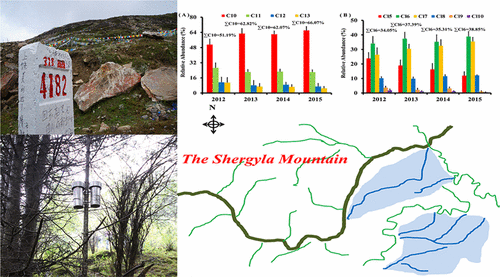当前位置:
X-MOL 学术
›
Environ. Sci. Technol.
›
论文详情
Our official English website, www.x-mol.net, welcomes your
feedback! (Note: you will need to create a separate account there.)
Spatiotemporal Distribution and Alpine Behavior of Short Chain Chlorinated Paraffins in Air at Shergyla Mountain and Lhasa on the Tibetan Plateau of China
Environmental Science & Technology ( IF 10.8 ) Pub Date : 2017-09-22 00:00:00 , DOI: 10.1021/acs.est.7b03457 Jing Wu 1, 2 , Wei Gao 1, 2 , Yong Liang 3 , Jianjie Fu 1 , Yan Gao 1 , Yawei Wang 1, 2, 3 , Guibin Jiang 1
Environmental Science & Technology ( IF 10.8 ) Pub Date : 2017-09-22 00:00:00 , DOI: 10.1021/acs.est.7b03457 Jing Wu 1, 2 , Wei Gao 1, 2 , Yong Liang 3 , Jianjie Fu 1 , Yan Gao 1 , Yawei Wang 1, 2, 3 , Guibin Jiang 1
Affiliation

|
Pristine high-altitude mountains are ideal areas for studying the potential mechanism behind the long-range transport and environmental behavior of persistent organic pollutants in remote areas. Short chain chlorinated paraffins (SCCPs) are the most complex halogenated contaminants in the environment, and have attracted extensive worldwide interest in recent years. In this study, the spatiotemporal concentrations and distributions of SCCPs in air collected from Shergyla Mountain (located in the southeast of the Tibetan Plateau) and Lhasa were investigated during 2012–2015. Generally, the total SCCP levels at Shergyla Mountain and Lhasa were between 130 and 1300 pg/m3 and 1100–14440 pg/m3, respectively. C10 and C11 components were the most abundant homologue groups, indicating that lighter SCCP homologue groups are capable of relatively long-range atmospheric transport. Relatively high but insignificant atmospheric SCCP concentrations at Shergyla Mountain area and Lhasa were observed from 2013 to 2015 compared with 2012. At Shergyla Mountain, SCCP concentrations on the eastern and western slopes increased with altitude, implying that “mountain cold-trapping” might occur for SCCPs. A back-trajectory model showed that SCCP sources at Shergyla Mountain and Lhasa were primarily influenced by the tropical monsoon from Southwest and South Asia.
更新日期:2017-09-22











































 京公网安备 11010802027423号
京公网安备 11010802027423号